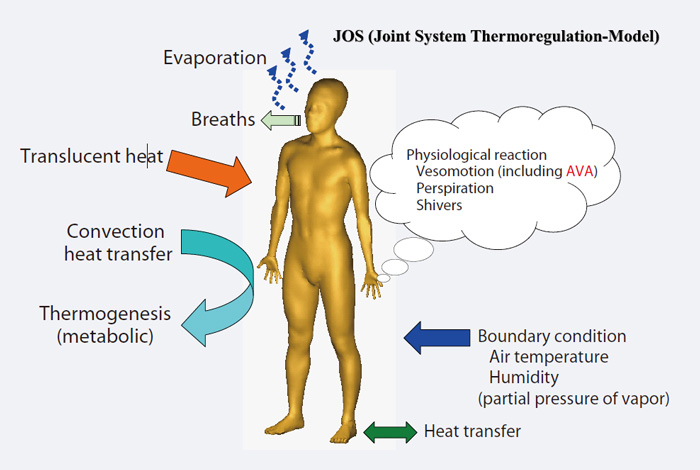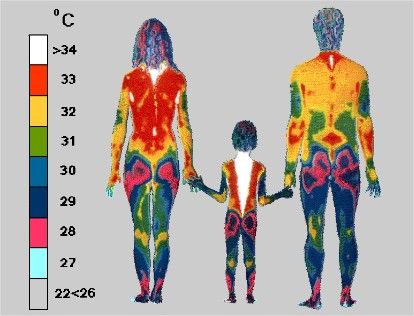Thermal comfort and wellbeing
The thermal comfort of an occupant can affect his or her wellbeing in a number of ways. This article will go through some of these, following on from a description of thermal comfort and how it can be quantified.
The thermal comfort of a person is described as 'that condition of mind that expresses satisfaction with the thermal environment and is assessed by subjective evaluation'. CIBSE comfort guide states the main aim is 'to keep most of the people happy most of the time' (Race G.)
The thermal comfort of an individual is personal and varies greatly from person to person and gender.
The subjective evaluation usually suggests a survey is needed to get the personal input from each of the occupants of a building. The large range of conditions and number of people required to give proper averages make this impractical in the majority of cases and cannot be done pre-occupation.
A different approach consists of measuring environmental conditions and then calculating the thermal comfort indices, which relate to the measured values and calculated indices as if a range of people were surveyed.
The standards BS EN ISO 7730 and ASHRAE 55 give methods for taking the environmental measurements and subsequent calculations to give quantified numbers to compare thermal comfort between buildings and different conditions within the same building. The measured values required by the standard are; air speed, turbulence intensity (using the standard deviation of air speed), air temperature, black globe temperature/operative temperature and relative humidity.
The thermal comfort calculations provide values for the Draught risk, Predicted Mean Vote (PMV) and the Predicted Percentage Dissatisfied (PPD):
- The Draught risk is an indication of the percentage of people that would perceive a draught given the measured conditions and uses air temperature, air speed and turbulence intensity.
- The PMV is a prediction of the average vote of a large group of people occupying the space as if a survey was conducted on a scale of -3 to +3; where '-3' indicates feeling cold, '+3' indicates feeling hot and '0' is comfortable.
- The PPD is an estimate of the percentage of people who would find the space uncomfortable, based on the PMV results.
The calculations of PMV and PPD take into consideration the insulation provided by clothing (CLO) and the activity of the people working/living in the space (MET).
The CLO is a measure of the average clothing insulation and the MET is a measure of the heat output from an average person doing a stated task in the space. The standards give methods to calculate the CLO and MET for a space, however, the actual individual values can change drastically depending on the occupiers of the space, e.g. an office space versus a supermarket or factory floor where the activity level is significantly different, therefore the specific CLO and MET must be chosen carefully to give true indicative values of PMV and PPD.
One thing to note is that the PPD has a calculated minimum of 5%, as for the CLO and MET there will always be some people who will feel either hot or cold, however, this is normally compensated by changing an individual’s CLO, i.e. if a person is in an office and wearing a jacket, and the dress code allows, they will remove it when feeling hot, etc.
The effect on wellbeing of thermal comfort is becoming a focus of study and is coming to the attention of building owners and occupiers. The reason for the focus is that detrimental thermal comfort can have a significant effect on the morale and in some cases even the mental and physical health of the occupants of any building.
Problems with morale or health can affect productivity. A measurement of the thermal comfort, either pre-occupation by heat-load testing or of the occupied building, can identify problems or show that the building conforms with the expected comfort levels required, e.g. the BS EN ISO 7730 standard has classifications of the space depending on the PMV, PPD and other factors.
The distraction caused by adverse thermal comfort can be significant and can lead to occupants feeling the space is uncomfortable even if the conditions in the space improve, e.g. either through changes to the ventilation system, or by moving an individual to a more suitable thermal environment. If a space is felt to be too hot or too cold for too long and no actions are taken, the perception of the occupants can become biased. Perceived long term thermal discomfort can be hard to dispel and productivity can be negatively affected.
This article was originally published here by BSRIA in Jan 2017. It was written by Calum Maclean, Senior Research Engineer, BSRIA Sustainable Construction Group, but has subsequently been edited by others. See the article history for more information.
--BSRIA
[edit] Related articles on Designing Buildings Wiki
- A Practical Guide to Building Thermal Modelling.
- BREEAM Thermal comfort.
- BSRIA articles on Designing Buildings Wiki.
- Building related illness.
- Heat stress.
- Human comfort in buildings.
- Indoor air quality.
- Maximum and minimum workplace temperatures.
- Measuring the wellbeing benefits of interior materials.
- Overheating in homes – BSRIA residential network event.
- Sick building syndrome.
- Temperature in buildings.
- The Flourish Model to enhance wellbeing.
- Thermal comfort in buildings.
- Thermal environment.
- Wellbeing.
- Wellbeing considerations for property managers.
- What we know about wellbeing.
Featured articles and news
RTPI leader to become new CIOB Chief Executive Officer
Dr Victoria Hills MRTPI, FICE to take over after Caroline Gumble’s departure.
Social and affordable housing, a long term plan for delivery
The “Delivering a Decade of Renewal for Social and Affordable Housing” strategy sets out future path.
A change to adoptive architecture
Effects of global weather warming on architectural detailing, material choice and human interaction.
The proposed publicly owned and backed subsidiary of Homes England, to facilitate new homes.
How big is the problem and what can we do to mitigate the effects?
Overheating guidance and tools for building designers
A number of cool guides to help with the heat.
The UK's Modern Industrial Strategy: A 10 year plan
Previous consultation criticism, current key elements and general support with some persisting reservations.
Building Safety Regulator reforms
New roles, new staff and a new fast track service pave the way for a single construction regulator.
Architectural Technologist CPDs and Communications
CIAT CPD… and how you can do it!
Cooling centres and cool spaces
Managing extreme heat in cities by directing the public to places for heat stress relief and water sources.
Winter gardens: A brief history and warm variations
Extending the season with glass in different forms and terms.
Restoring Great Yarmouth's Winter Gardens
Transforming one of the least sustainable constructions imaginable.
Construction Skills Mission Board launch sector drive
Newly formed government and industry collaboration set strategy for recruiting an additional 100,000 construction workers a year.
New Architects Code comes into effect in September 2025
ARB Architects Code of Conduct and Practice available with ongoing consultation regarding guidance.
Welsh Skills Body (Medr) launches ambitious plan
The new skills body brings together funding and regulation of tertiary education and research for the devolved nation.
Paul Gandy FCIOB announced as next CIOB President
Former Tilbury Douglas CEO takes helm.
UK Infrastructure: A 10 Year Strategy. In brief with reactions
With the National Infrastructure and Service Transformation Authority (NISTA).


























